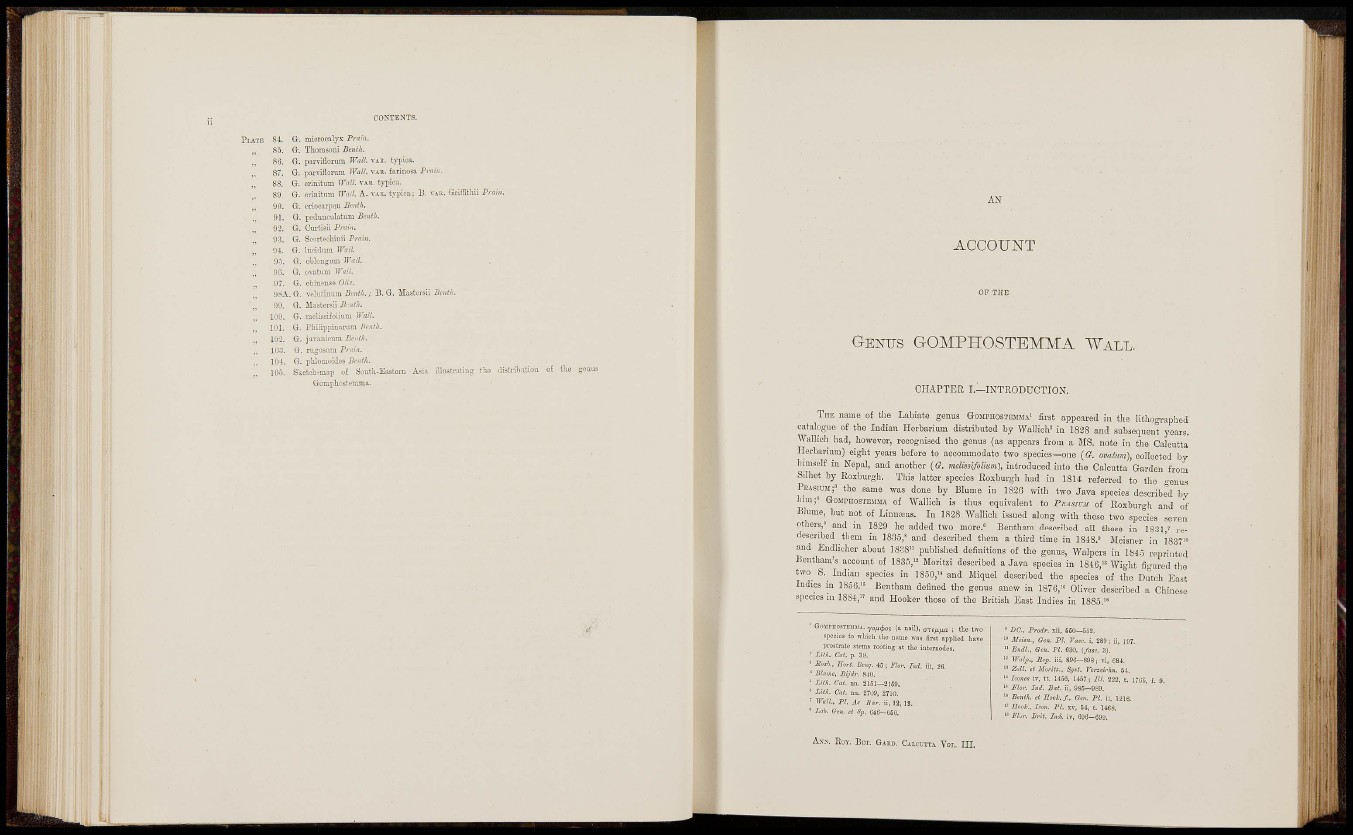
CO>'TENTS.
Mil
84. G. microcalys Pra'.n.
85. G. Thomsoni Beiii/i.
88. G. pai-Tiflomni Wall. var. typiua.
87. G. iiarTiaoriim Wall. vak. farinosa Pniin.
88. G. crinitum IFall. tak. typica.
89. G. nriuitani JVii'l. A. var. tj'pioa; 13. v.iit. Griffithii Prain.
90. G. eriocarpQU Benlh.
91. G. pcdimoulatum Beufh.
9Í2. G. Ciirtisii
93. G. Sofirtechinn Prniii.
94. G. Incidimi Wall.
9.5. G. oblougum Wall.
f)6. G. ovatum Wall.
97. G, chinense Olic.
G. velutinum Beiit/t. ; B. G. Mastersil Beiit/i.
99. G. ilnstersii
100. G. melisáfolium Wall.
101. G. Pbiiippiuarura hcnih.
102. G. jaTaQÌcum Bc»lh.
lOy. G. rugosum Prnin.
lOi. G. pUomoiiles Benth.
105. Sketch-mnp o£ Sonth-EasEaru Asia ülnstrating tlie distiibutioQ of tlie
Gompbostemma.
ACCOUNT
GENUS GOMPHOSTEMMA WALL.
CHAPTER I.—INTRODUCTION.
The name of the Labiate genus Gomphostemma' first appeared in the lithographed
catalogue of the Indian Herbarium distributed by Wallich- in 1828 and subsequent years.
Wallich had, however, recognised tlie genus (as appears ft-om a MS. note in the Calcutta
Herbarium) eight years before to accommodate two species—one (G. ovaétcm), collected by
himself in Nepal, and another ((?. melissifoUum), introduced into the Calcutta Garden from
Silhet by Roxburgh. This latter species Roxburgh had in 1814 referred to the -enu..
Pkasium;' the same was done by Blurae in 1826 with two Java species described by
inin; Gomphosteuma of Wallich is thus equivalent to PR.ÌSIUÌ[ of Roxburgh and of
Bhime, but not of Linnfeus. In 1828 "Wallich issued along with these two species seven
others,' and in 1829 he added two more.« Bentham described all these in 1831,' redescribed
them in lS35,s and described them a third time in 1848.» Meisner in 1837'»
and Endlidier about 1828" published definitions of the genus, Walpers in 184-5 reprinted
Bentham's account of 1830,'^ Moritd described a Java species in 1846," Wight figured the
two S.^ Indian species in 1850," and Miquel described the species of the Dutch East
Indies in 185G." Bentham defined the genus anew in 1876,Oliver described a Chinese
species 111 1884," and Hooker those of the British East Indies in 1885.»
' Go^PnosTEaMi, ^Oii^o? (a u.U), , (to two
speeics to wliich tlio nnino first applied have
prostrate stems rooting at tho iuternodes.
= LUh. Cat. p. 39.
= Jiui-J,, Ilort. Smg. 45 i Flo-'. Ind. iii, 26.
^ BhuM, Bijdr. 8.10.
^ Lith. Cat. nn. 2131—3169.
' LUh. Cat. UD. 2/09, 2710.
• TFb/;,. PI. A^ Sar. ii, 13, 13.
' Lah. Hen. et Sp. CIS—e60.
' D0„ £'>-odr. sii, 660-552.
"" McUn., Gen. Fl. Vasc. i. 289; ii, 197.
" ERdl. Gen. Fl. 630, {fase. 3),
Walp., Rcp. iii, 89C—898; yi. 68i.
" Zoll. et Moñtz.. S¡/H. Veneirki,. 51.
" Iconeí ir, tt. 1156, 1457; III. 222, t. 17Üi, f. !
" Flor. Ind. Bal. ii. 985—989,
" Benth. et Saoh.f., Gen. Fl. ii. 1216.
Bmk.. Icón. Fl. XV, 54, t. 1468.
i'lur. Brit. JhA ít, 696-6ÍJ9.
Ax.v. Eoy. Box, Gahd. Calcutta Vol. HI.